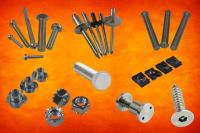 Add My Company
Add My Company
Sign In
Some advantages of modern mechanical fasteners By Kevin Moorcroft, M.D. at Challenge Europe Ltd
09-07-2018

In the modern world there are many issues coming to the fore such as the reduction of chemicals hazardous to your health (RoHS – Restrictions of Hazardous Substances and REACH - Registration, Evaluation, Authorisation and Restriction of Chemicals). In addition industry is continually being charged to reduce wastage and improve recyclability as well improve working environments, health and safety being key issues that most companies come across on a regular basis.
Mechanical fasteners in one form or another have been in existence almost from the cave man days with developments in more recent years enabling them to be used successfully in most types of assembly environments and at the same time satisfying the requirements of safety, quality and cost. They continue to be a simple solution to assembly problems providing a system of positive connection with low risk, which can be easily disassembled. They have no thickness limitation, are not environmentally sensitive and provide through-thickness reinforcement, with low sensitivity to peel stresses and have no major residual stress problems.
Above all they are simple – joint configuration is simple, manufacturing processes are simple, inspection is simple and maintenance is simple. Simplicity can be a major advantage in most applications.
Simplicity however does not mean they are incapable of sophistication with major advantages over chemical fastening adhesives. For example, threaded fasteners are commonly used with a torque adjustable closure force permitting pre-loading of the joint to allow it to adapt to variable loads from engines to couplings.
Similarly, the structural integrity, strength and security of mechanical fasteners can be designed to encompass the needs of vandal-resistance, to accommodate the extreme loads of vandal attack and to resist tools. In our drive for the new it is easy to forget the advantages of the old technologies.
With a mechanical fastener, when it is fixed, it is fixed and with a little thought it stays fixed. You can have confidence in what you feel when you fit it and what you see when you inspect it. So it is worth considering that most mechanical fasteners exhibit a common range of attributes:
They are suited to production - especially where dis-assembly is likely to be needed. Threaded fasteners and rivets are easy to use in the manufacturing environment where everybody has appropriate tools, experience and expertise.
They have predictable, reliable and often very high performance – they are a known quantity from simple and robust (to high specification) materials with positive known characteristics, including sealing and anti-vibration.
They are easy to maintain and are easily removed for maintenance and repair, even small components can be replaced from larger assemblies. Assemblies using mechanical fasteners can generally be taken apart for ease of repair and maintenance, even rivets can be drilled out allowing access in sheet metal fabrications. Whilst there are some adhesives that will allow disassembly this often requires considerable time and the use of chemical solvents to clean and prepare the surfaces for re-assembly.
Mechanical fasteners provide certainty of fixing as they eliminate the risk of faulty and potentially scrap assemblies by providing a visible fixing that is not subject to a failed bond scenario.
Reduced surface preparation – generally mechanical fasteners require no special preparation of mating surfaces, eliminating the need for cleaning solvents, etc. and provide an immediate fix – unlike many adhesives there is no delay in production due to allowances for cure times.
Adjustment during assembly is readily achieved since some assembly jobs entail a trial and error approach, with mechanical fixings you have the provision to adjust as many times as is necessary without being limited by a cure time.
Mating Components – fasteners don’t have any detrimental effect on mating components as there is no risk of chemical created structural change. In addition dissimilar materials can be joined, although care is recommended to prevent the risk of galvanic corrosion.
They are environmentally friendly – due to their recyclability you don’t have the problems associated with having to safely and legally dispose of chemical waste that could occur with adhesives products. Regarding environmental concerns we find that generally all fasteners are recyclable, either by reuse in their original condition or by melting down. In this respect steel is quite an environmentally friendly material.
Low impact on the work environment - mechanical fasteners have the benefit of being able to be utilised in all weather and environmental conditions that man can survive, no need to provide specialised assembly areas, such as fume extraction or controlled temperature. In addition mechanical fasteners are less messy to use, require less specialised training, and generally don’t require respiratory/allergy monitoring of users.
They have an extended shelf life and maintain their value over time – unlike many adhesive products, mechanical fasteners do not require specialised storage facilities and provided they are kept in a dry environment their shelf life is virtually indefinite.
Likewise for life in service – look after them and they can last many lifetimes – for example the Eiffel Tower, opened in 1889, with 2.5million rivets used in its construction. Then there is the Forth Rail Bridge, opened 1890, 6.5 million rivets, and the Sydney Harbour Bridge opened in 1932, with 6 million rivets used.
For more information on Some advantages of modern mechanical fasteners By Kevin Moorcroft, M.D. at Challenge Europe Ltd talk to Challenge (Europe) Ltd
Enquire Now
More News
List your company on FindTheNeedle.

